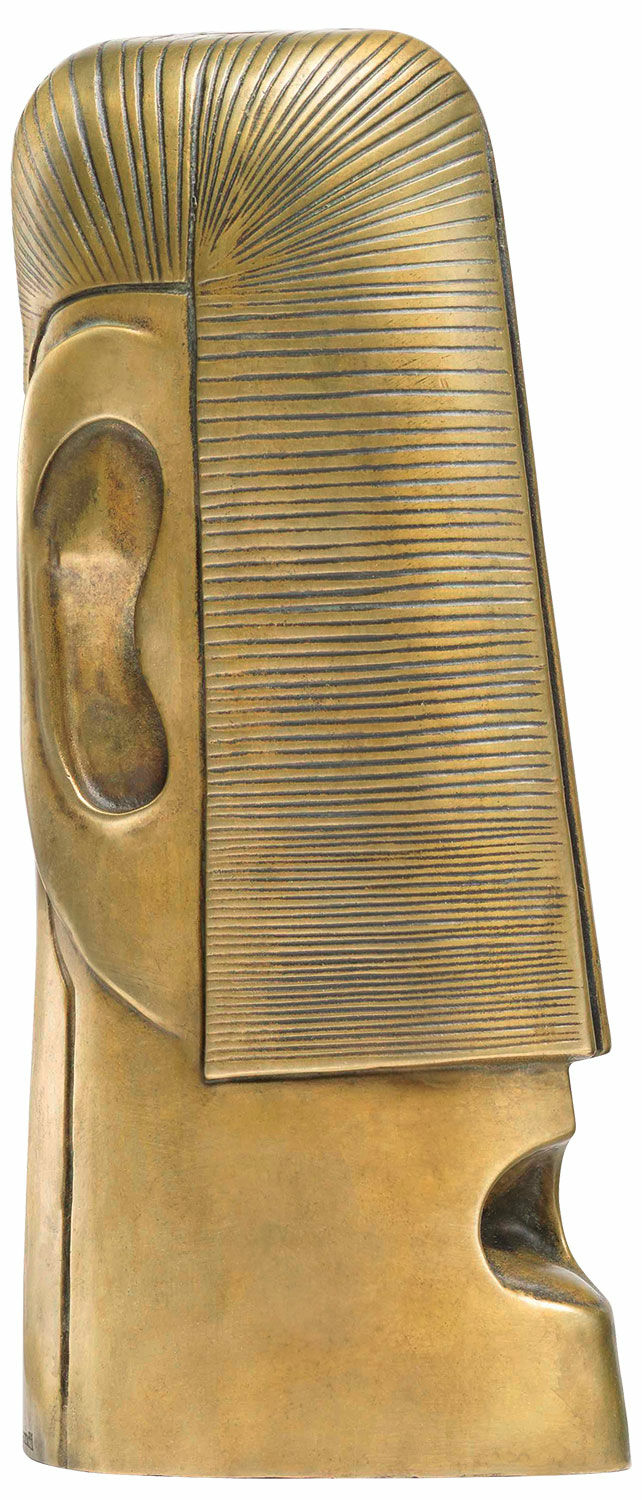Sculpture "Large Tattoo" (1982), reduction in light bronze
Sculpture "Large Tattoo" (1982), reduction in light bronze
Quick info
ars mundi Exclusive Edition | limited, 49 copies | numbered | signed | foundry hallmark | certificate | bronze | chased | polished | patinated | reduction | size 24.5 x 10 x 11.5 cm (h/w/d) | weight approx. 3.2 kg
Video
Detailed description
Sculpture "Large Tattoo" (1982), reduction in light bronze
Rainer Kriester (1935-2002) is one of the most important German sculptors of the late 20th century. He achieved his international breakthrough in the 1980s, creating numerous "head signs", some of them are monumental figures in bronze, wood and stone. They are not masks, but rather individual heads, engraved with the traces of life lived and experienced.
The artist's wish was to produce scaled-down versions of his large-scale works in bronze. As an ars mundi Exclusive Edition, we have now produced a numbered and signed special edition of 49 copies each in either dark or light patinated bronze.
Original: 1982, ash wood, 195 x 60 x 95 cm, WVZ 230, the private property of the Kriester family.
Fine bronze sculpture, cast using the Lost-Wax-Process, chiselled by hand, polished and lightly patinated. Moulded and reduced directly from the original. Limited edition of 49 copies, individually numbered, signed and hallmarked with the foundry stamp. With numbered certificate of authenticity and limitation. Size 24.5 x 10 x 11.5 cm (h/w/d). Weight approx. 3.2 kg. ars mundi Exclusive Edition.

About Rainer Kriester
1935-2002
"I am a realist by nature, but I do not work realistically. I am not an abstractionist, but I seek abstraction." This is how Rainer Kriester summarised his work.
Kriester is one of the most important German sculptors of the late 20th century.
Kriester, a medical student, fled from the GDR to West Berlin after being imprisoned for a year for "anti-government remarks". There he began to study painting at the Berlin Kunsthochschule in 1961. In 1970 he started working intensively as a sculptor.
In the 1980s, he achieved his international breakthrough, during which he moved his place of work gradually to the Ligurian town of Vendone. This is also where he created many of his "head signs". Some of them are monumental figures made of bronze, wood, and stone. They are not masks, but highly individual heads, engraved with the traces of life lived and experienced.
Wieland Schmied, art historian and long-time president of the Bavarian Academy of Fine Arts, describes his sculptures as "still vibrating with exciting life under their skin".
The most prominent version is the 1.50 m high "White Head Sign" from 1984-1987. Along with works by Chillida and Lüpertz, it belongs to the important sculpture collection of the Federal Chancellery.
An alloy of copper with other metals (especially with tin) used since ancient times.
When casting bronze, the artist usually applies the lost-wax technique which is dating back more than 5000 years. It's the best, but also the most complex method of producing sculptures.
First, the artist forms a model of his sculpture. It is embedded in a liquid silicone rubber mass. Once the material has solidified, the model is cut out. The liquid wax is poured into the negative mould. After cooling down, the wax cast is removed from the mould, provided with sprues and dipped into ceramic mass. The ceramic mass is hardened in a kiln, whereby the wax flows out (lost mould).
Now we finally have the negative form, into which the 1400° C hot molten bronze is poured. After the bronze had cooled down, the ceramic shell is broken off and the sculpture is revealed.
Now the sprues are removed, the surfaces are polished, patinated and numbered by the artist himself or, to his specifications, by a specialist. Thus, each casting becomes an original work.
For lower-quality bronze castings, the sand casting method is often used which, however, does not achieve the results of a more complex lost-wax technique in terms of surface characteristics and quality.
Sculptural representation of person's head and shoulders.
Graphic or sculpture edition that was initiated by ars mundi and is available only at ars mundi or at distribution partners licensed by ars mundi.
Term for an art object (sculpture, installation), which is produced in multiple copies in a limited and numbered edition according to the artist‘s will.
Artist's multiples have been called the most accessible and affordable art on the market.
A plastic work of sculptural art made of wood, stone, ivory, bronze or other metals.
While sculptures from wood, ivory or stone are made directly from the block of material, in bronze casting a working model is prepared at first. Usually, it is made of clay or other easily mouldable materials.
The prime time of sculpture after the Greek and Roman antiquity was the Renaissance. Impressionism gave a new impulse to the sculptural arts. Contemporary artists such as Jorg Immendorf, Andora, and Markus Lupertz also enriched sculptures with outstanding works.












